It took a while. A long while. Ten years in total. But Don Day has finally embraced a Mexican tradition. Don Day now eats paella on Sundays.
For Mexicans, eating out has always been more of a weekend thing. In fact most restaurants don’t even offer classic dishes like pozole, menudo and paella except on weekends.
For old retired people like Don Day that took a lot of getting used to. For old retired people like Don Day a lot of things take a lot of getting used to. Including knowing what day of the week it is.
“I like egg and chips on a Tuesday. Today’s a Thursday. Where’s me steak?”
Yes, Don Day’s seen Shirley Valentine. And even without Don Day’s Wife insistence. And like Shirley’s husband, Don Day grew up with certain days of the week representing certain dishes. Shepherd’s pie on Mondays. Fish and chips on Fridays. And roast beef on Sundays. Almost always roast beef on Sundays.
After Don Day grew up…though some question that actually ever happened…Don Day kept that Sunday tradition. Prime rib of beef, mashed potatoes, roast onions and carrots, baby peas and gravy. And when Don Day started his winters in San Miguel de Allende, Mexico, Don Day took that tradition with him. At least as best he could.
There was a problem in Mexico though. Good, well-marbled beef was difficult to find in San Miguel de Allende. And good prime rib roasts that still had the prime rib bones attached, the ones that Don Day finished every Sunday dinner gnawing on, were almost impossible to find. So Don Day made compromises. Sometimes on Sundays he had roast pork instead. Sometimes on Sundays he had pot roast instead of prime rib roast. And sometimes on Sundays, he had paella.
Until this year. This year things began to change. This year Don Day began to do more things like Mexican men. This year Don Day began to wear his shirts inside his pants. This year Don Day began to wear jeans instead of shorts. This year Don Day contemplated dying his hair black…until he discovered that they don’t give lack of quantity discounts. This year Don Day began to occasionally eat lunch at 2:00 pm instead of Noon. And this year Don Day began to eat paella at many a Sunday lunch.
Except for this week. This week Don Day and some of Don Day’s friends were going to The Literary Cabaret in San Miguel and it began at 5:00 pm. If Don Day went with Don Day’s friends for paella at 2:00 pm there would be wine. And if there was wine, no matter how witty The Literary Caberet might be, Don Day might nod off.
So instead, Don Day asked Chu the owner and chef of the namesake La Bodega de Chu if he could have some fresh paella for us at 7:30 pm and Chu, as Don Day knew he would, said, “Of course.”
Don Day learned to like paella when, for a brief time, he lived humbly on the south coast of Spain. Don Day liked paella because paella was usually the cheapest thing on the menu and, with lots of rice, usually the most filling. Don Day only remembers one type of paella in the cheap restaurants he ate at during those days. The ingredients often had more to do with what was left in the kitchen from the day before as opposed to what was right according to some ancient Valencian recipe.
As Don Day matured, or perhaps I should more appropriately say got older, he became somewhat obsessed with food to the point where he wanted to devour everything written with his brain and everything cooked with his belly. It was then that he learned more about paella.
There are unofficially three types of paella: Paella Valenciana, Seafood Paella and Paella Mixta. Most of the time in Mexico and in most countries outside of Spain, one is served Paella Mixta. Mixed paella is basically an excuse to put anything in a rice dish that’s cooked in a shallow pan with something that colors it yellow. Unless you’re a purist, and Don Day is absolutely not, you can get some mighty good meals when a chef makes a Paella Mixta.
About a year ago, Don Day received a recommendation about a source for paella in San Miguel de Allende.
Don Day was in La Europea, the San Miguel liquor store, mourning the fact that, once again, they had no Pascual Toso Cabernet Sauvignon (it happened again last week) but rejoicing in the fact that the Pascual Toso Reserve Cab was reduced to 214.21 pesos a bottle (that didn’t happen again last week). It was there that a guy in a sweat-stained Jose Cuervo baseball cap and a shirt with no sleeves came up to him and said, “You’re Don Day aren’t you?”
This may seem like an easy question to answer but, in the old days, when Don Day occasionally spent a little horizontal time with other men’s paramours, this would have frightened Don Day. But since Don Day married Don Day’s Wife, he no longer sleeps with other women, so he wasn’t particularly nervous. Though he still answered “guilty”.
“Why haven’t you written about La Bodega de Chu?”, the sleeveless guy who’s name was Eric asked me. “They make the best paella in town.”
I suggested that never ever hearing about La Bodega de Chu was ample reason and then, after some brief conversation to see if, by chance, Eric was Senor Chu’s (if there was a Senor Chu) brother-in-law, I came to the conclusion he was just another foodie (did Don Day just put “just another” in front of “foodie”?) with a particular liking for paella.
From the address, I recognized that La Bodega used to be Carcasonne and decided to stop in and check it out. Carcasonne was always one of the most exquisitely beautiful restaurants in San Miguel and I was thankful that La Bodega de Chu hadn’t changed a thing. Apart from a glass wall that Carcasonne built to section off a wine cellar, virtually everything in the structure is original. It’s like stepping into 1850. It looks like, at one point, one building was split into three and, from the stone floor, the herringbone brick ceiling and high arches, La Bodega de Chu may have been where the wagons were stored and possibly repaired on their trips from the gold and silver mines to Veracruz.
I asked for Chu and out from the kitchen came a middle-aged guy who with the addition of chin hair would have no trouble getting a job in a department store in December. He not only walked jolly, he talked jolly, particularly when it came to paella.
That was a beginning of my love affair with La Bodega de Chu‘s paella and why it found us in the restaurant on Sunday night.
We passed on starters as one always should when one is having paella. And ordered up some Argentinean Reservas that we thought would wash it down well. Yllum Sauvignon Blanc for Lorainna and Cliff. Yllum Pinot Noir for Don Day and four others. And sparkling water for Monique who despite her healthy ways never frowns at our excess.
I couldn’t help but notice how elegant Mariana’s presentation is when she’s serving wine. I dream I’m perhaps in a Parisian restaurant that has recently received its second Michelin star and am being fawned over by a sommelier with a tastevin hanging from a silver chain who doesn’t know how shallow my pockets are. Except Mariana never has her nose in the air and, of course, the French would never allow a woman to choose and serve wine. Would they?
The first time I had Chu’s paella I asked him what was in it and he told me, “In the old days, paella was everything you could hunt. These days, it’s everything that tastes good.”
We became a little more formal and Chu told me his birth certificate read Luis Alberto Lopez Paez and he had become Chuchucito when his little brother got a little tongue tied with what the certificate said. Chu had owned the building on Correo since 2000 but back in the eighties it had once been a restaurant called The Bodega that some of the town’s oldtimers might remember. When Chu bought it he converted it to a furniture store which is Don Day’s oldest memory of the place. A couple of years ago, Chu installed an industrial kitchen (a business he’s still in) and leased it to the people who ran Carcasonne. In January of 2013, he opened La Bodega de Chu.
Don Day hasn’t had a lot of Pinot Noir from Argentina. Mostly because there isn’t a lot of Pinot Noir from Argentina. Though Don Day would never buy Yllum in a retail store because Don Day readily admits that label designs often influence his initial wine purchases, and also admits he only chooses wines with names that he can understand and pronounce, Don Day likes Yllum Pinot Noir a lot. It has lots of berry fruit like new world pinots yet is quite refined like a French Burgundy. Harry and the rest of the crowd expressed their pleasure as well.
The original Paella Valencia consists of rice, green vegetables, beans, rabbit (or sometimes chicken or duck), snails and seasoning. Paella de Marisco consists of rice, seasoning, and various combinations of clams, mussels, lobster, shrimps, cuttlefish, squid, and other creatures that like their water salty (but not the ones with gills); onions, garlic, tomatoes and seasonings are also often included. Paella Mixta, La Bodega de Chu‘s specialty consists of virtually anything and everything.
The word paella probably comes from the shallow, steel pan that the dish is traditionally cooked in and is still used in La Bodega de Chu‘s kitchen. Inside is a rainbow of expectations and I asked Chu to detail what was in there. I should have asked what wasn’t.
“There are clams, shrimp, chicken, pork ribs, baby calamari, octopus, bacon, chorizo Espanol, green beans, red pepper, green pepper, olive oil, saffron and at least a couple of things I’ve forgotten,” Chu told me. “You can add anything you want to a Paella Mixta. As long as everything works together.”
Everything did. The baby clams were sweet. The shrimp were just barely cooked. The mussels were still moist. The octopus wasn’t chewy. The chicken came from the tastiest thigh sections. The peas (one of the things Chu hadn’t mentioned) tasted fresh. The Spanish sausage was one of the best Don Day had ever had.
A really good paella doesn’t have a single taste, it has a lot of tastes. And those tastes come through both individually and in harmony. There was one taste in paella though that one can never be sure of. Saffron is the most expensive food, by weight, in the world. So often, when you eat paella, you’re tasting artificial flavors and viewing artificial colorings that are used to create that vibrant amber glow.
I remember once wanting desperately to ask Chu if it was real azafran (as saffron is called in Spanish)? I couldn’t. Well not politely anyway. But Don Day has never been renowned for politeness.
“Was that real azafran?”, I blurted. Chu walked away from the question; I was afraid it was in disgust. A few seconds later he returned. In his hand was a glass jar. It was Mancha, the world’s best Spanish saffron. He said I could have the empty jar and we talked about how, if you filled it with olive oil and a clove of garlic, you could still get a lot of the saffron taste from it.
Now Don Day wouldn’t say that La Bodega de Chu‘s Sunday night paella was perfect. It needed salt. But that was easily remedied with the shaker on the table. However, La Bodega de Chu‘s paella also needed oil. That used to be easily remedied with bottles of olive oil on the table, one with chilis and one without. But not any more. They’re gone. Demand them if you decide to start spending your Sundays like Don Day does.
Paella isn’t the only dish Chu is famous for. His panna cotta is also a signature piece. A good panna cotta shakes like jelly; the panna cotta we ordered on Sunday night shimmied like someone’s sister Kate. It was creamy, sweet but not too sweet, coated with caramel and decorated with chocolate sauce. You can only handle a dessert that’s light after paella. This one almost floated.
Now will Don Day return to his Sunday prime rib addiction when Winter’s over and he returns to Canada? Of course he will. There’s only a certain amount of new tricks you can teach old dogs. But until then, Sundays will definitely never be the same.
La Bodega de Chu is located at Correo #34 in San Miguel de Allende, Mexico. The restaurant is open from 1:00 pm to 11:00 pm, Wednesday through Sunday. Paella is available on Saturdays and Sundays.


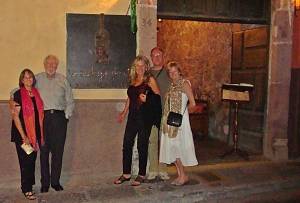
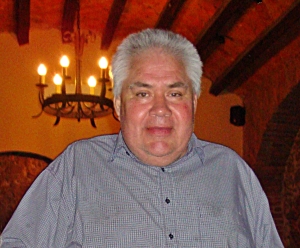
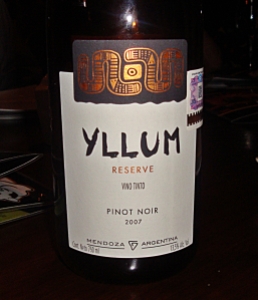
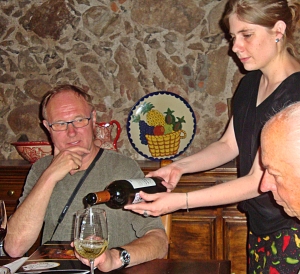
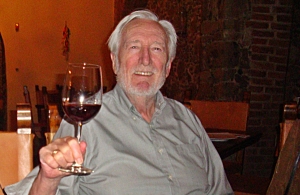
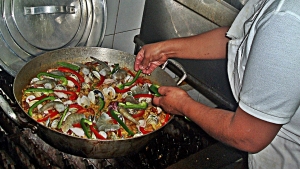
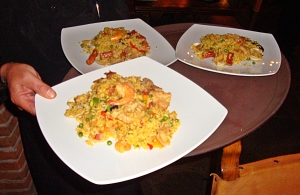
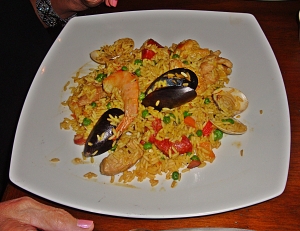

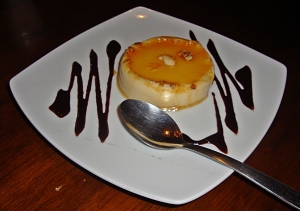
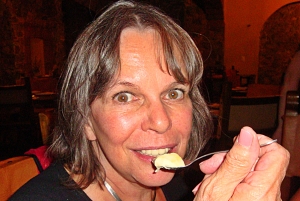
Ah……….. the Bodega.
Date: Wed, 12 Mar 2014 17:07:24 +0000 To: peteross@sympatico.ca
I figured it was just a matter of time until Don Day found Bodega de Chu. I didn’t think I liked paella until I tasted theirs. Two questions though:
1) what is the “azafran” sold at Bonanza in the spice department? It certainly doesn’t taste like saffron and it’s way too cheap to be saffron. Can one find Spanish saffron in SMA?
2) is it traditional to leave the shells on the shrimp when adding it to paella? It’s the one thing I don’t like about it.
I also don’t know of any other place in town which serves you seconds if you want it and at no additional charge!
Bonanza’s azafran is actually turmeric which is what a lot of restaurants use to give paella its yellow color (and some flavor); I got excited when I saw the cheap price as well. And yes, it’s always shells on (so that the rich taste of the shells works its way into the juices) unless they’re cocktail shrimp.
And, although technically not a paella (there is apparently some debate about this, people often referring to it as paella negra), there is arrόs negre, made with cuttlefish and rice, and, according to Wikipedia, a dish of Valencian and Catalan origin. You can check out images of this dish and read some more about it at: http://en.wikipedia.org/wiki/Arr%C3%B2s_negre
Is this something Chu has done or, more importantly, will do?
You can check out this post to discover where I’d go for paella negra in San Miguel:
http://dondayinsma.wordpress.com/2014/01/12/paella-negra-black-is-the-new-orange/
And you’ll have to order it a couple of days ahead.
Many thanks.
And socarrat?
Isn’t that really what makes a paella?
Yet never any sight nor mention of it in SMA.
Casa de Conservas is where I’d go for socarrat. You can read about it here:
http://dondayinsma.wordpress.com/2014/01/12/paella-negra-black-is-the-new-orange/
Absolute deliciousness! Paella is awesome in any way it’s made.